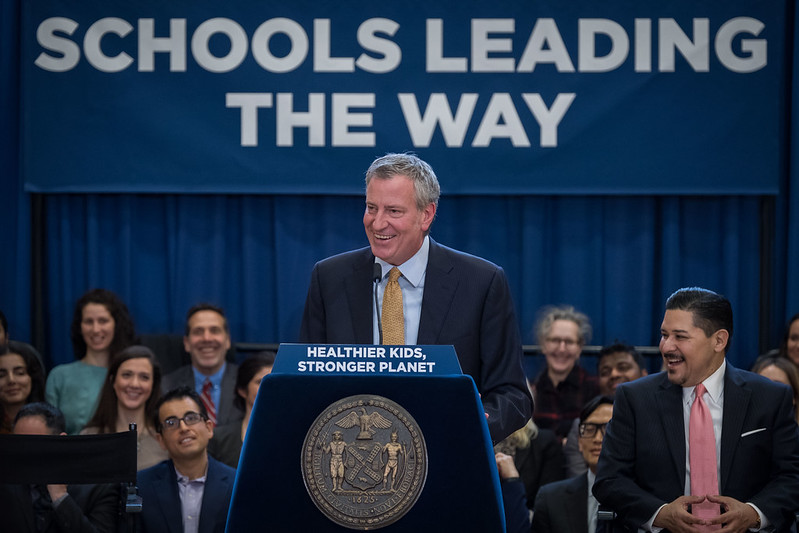
Mayor de Blasio & Chancellor Carranza (photo: Ed Reed/Mayor's Office)
Many of my colleagues are discussing whether or not it’s safe to go back to school buildings in New York City. Will buildings that were never clean before become clean now? Will buildings that were never properly ventilated suddenly become state of the art? Will children and teenagers observe social distancing in and out of school? I’ll leave all that to your imagination and focus mostly on the pedagogical.
It’s not hard to explain the best possible way to administer education. I know well, because I’ve been doing it for decades. Face-to-face instruction is optimal. I can give immediate oral and written feedback. My students can work with one another in pairs or other small groupings to reinforce whatever we’re learning. You never know what will happen, every day is different, and it’s the best job there is.
Of course, things are different now. We can’t simply go back this September to where we were last September because we all know the virus is still here and can surge back. We need only look south to Florida, to Texas, and elsewhere to see what will happen if we’re careless.
This year, we’re looking at what the mayor calls a hybrid school model—partly remote and partly in-person. At first blush, this looks like a reasonable compromise. When you look under the hood, though, there are a lot of major questions. For example, if I go in on Monday and teach 20-50% of my students, what are my other 50-80% going to be doing? Mayor de Blasio has absolutely no answer, expecting individual schools to perform miracles.
I once thought they’d be viewing my live lesson through video feed, but that doesn’t appear viable. Even if it were, how would the students interact? Would the live students see those online? Could they communicate? How would I turn my attention from one group to the other?
Instead, I’d be meeting with a group of up to 12 students, all masked and socially distanced. This would cramp my style -- and that of most teachers -- quite a bit. I’m accustomed to moving around the room while students are working, watching what they’re doing. I offer tips on work, admonitions to wake up, and whatever falls in between. I’m always watching. I can’t do that from behind the teacher desk.
While we’re on the subject, let’s talk about where the state wants that teacher desk. On page 29 of recently-released New York State Education Department guidelines, it says:
Turn desks (including teachers) to face in the same direction rather than facing each other to reduce transmission caused by virus-containing droplets (e.g., from talking, coughing, sneezing);
Evidently, either the students are now looking at the back of my head, or I’m looking at the backs of theirs. I’d probably opt for the latter so as to have a minimum idea of what’s going on. Talking face to face is specifically discouraged here. Add that to the Black Mirror atmosphere of masks and social distancing, the already draconian restrictions on social interaction, and you have a pretty depressing little classroom. I don’t see how this meets anyone’s social and emotional needs, let alone their educational needs.
Fortunately, in 50-80% of the cases, students will be in online classes and remote learning. While we were thrown into this with neither training nor support in April, we’re better at it now. We could be even better at it if the city were to offer us adequate support and training.
It’s paramount that students show us their faces during online classes. I don’t know whether or not that cute puppy picture in the digital classroom represents a student paying attention, taking a nap, or walking to the corner to get coffee. I don’t know whether those answers in the chat are being written by my student, by their friend, or by paid tutors who don’t actually care whether or not my student learns anything.
The city could invest in programs that support online learning. We should find programs that allow us to not only watch the students working in real time, see the work, and also to detect plagiarism. Nothing will be perfect, but that would be a great help. In normal times, I have my students do most of their writing in class because I’m weary of reading identical essays or being presented with pieces by hack writers on the internet.
The fact is that right now I can do a lot more for my students in a remote class than in the bizarre live setting being proposed by the mayor and the chancellor. I can see them all, they can all see me, and we can all interact online. With training, we can enable groups and pairs and do much better assessments.
Let’s use the buildings sparingly to support students (and teachers) who don’t have a quiet or safe place to work. When in-person counseling or support is absolutely necessary, let’s bring in students in groups so small we don’t have to indulge in ridiculous charades approximating classrooms.
To do best by our students at this time, we need to cut past appearances, and consider the best education we can give students while still keeping them (and staff) safe. We need to include them all, rather than teaching some and hoping others will figure out what we did on days they were out. Let’s drop the unworkable and preposterous hybrid idea, and give the best remote experience possible to our students for the next few months.
***
Arthur Goldstein is an ESL teacher and UFT chapter leader at Francis Lewis High School, and a UFT executive committee member. On Twitter @TeacherArthurG.
***
Have an op-ed idea or submission for Gotham Gazette? Email This email address is being protected from spambots. You need JavaScript enabled to view it.




